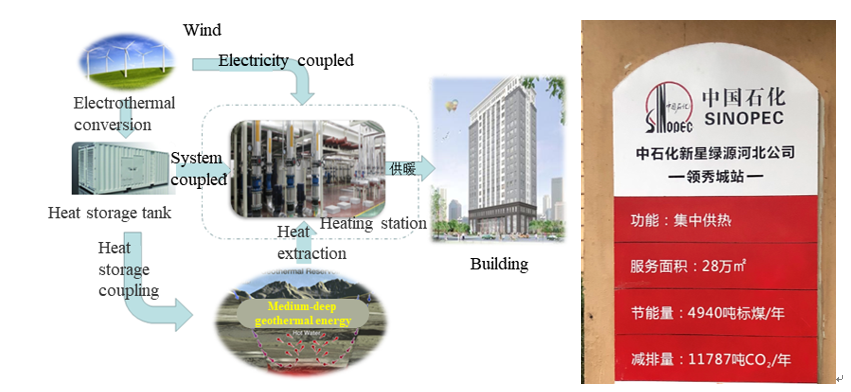- Home >> News >> Research Progress
New Progress in Geothermal Energy Storage by GIEC
China has unveiled a five-year plan from 2021 to 2025 on developing energy technology innovation and new thermal energy storage to absorb renewable energy such as wind and solar and achieve stable energy output. Due to the advantages of high energy storage capacity and efficiency, geothermal energy storage can absorb unstable renewable energy on a large scale and effectively solve the seasonal incompatibleness between supply and demand. It can be used as the first choice for long duration thermal energy storage and peak regulation of power system. Geothermal energy storage is mainly divided into borehole thermal energy storage (BTES) and aquifer thermal energy storage (ATES). BTES is not limited by hydrogeological conditions, and the storage temperature of ATES with a larger scale is higher, both of which are researched internationally. However, the existing geothermal energy storage systems cannot avoid the problem of low energy storage efficiency due to heat loss or thermal breakthrough, which limits their large-scale application.
Aiming at the heat attenuation of BTES, Prof. GONG Yulie and his colleagues from the Guangzhou Institute of Energy Conversion, Chinese Academy of Sciences (GIEC), studied medium-deep downhole coaxial heat exchanger (MDCHE) located in Jimo, Qingdao of China, which is one of BTES technologies and store heat by absorbing solar energy. In view of the barrier of long duration thermal energy storage in ATES, Prof. GONG Yulie cooperates with Prof. PANG Zhonghe and his colleagues from the Institute of Geology and Geophysics, Chinese Academy of Sciences (IGGE), and have developed key technologies for energy storage and energy supply system of medium-deep ATES with absorbing unstable intermittent energy sources such as wind and solar energy, and then carried out field test and verification based on the geothermal heating station located in Rongcheng, Xiong'an New Area of China.
In terms of BTES, available literatures have showed that the heating efficiency of MDCHE was directly affected by its heat transfer and flow performance, and the risk of heat attenuation increased as the heating cycle increase. The research team have tracked the heating operation data of MDCHE located in Jimo for four consecutive years, analyzed and verified the thermal attenuation phenomenon (as shown in Fig.1), and then proposed a scheme of BTES by absorbing solar energy in the non-heating period, so that the heating attenuation caused by cooling capacity accumulated in surrounding rocks can be effectively alleviated. Results of the study indicate that the trend of heating attenuation has changed significantly and stabilized after continuous heat input to the rock during non-heating period every year. Relevant research results were published in Energy with the title of “Thermal attenuation and heat supplementary analysis of medium-deep coaxial borehole system-based on a practical project” which is a top academic journal in the international energy field.

Figure 1. Basic principle of BTES and prediction of outlet water temperature and heat supply after 20 years heating period (Image by ZHANG Yuanyuan)
In terms of ATES, the research team analyzed the physical and chemical mechanism of the heating system based on geothermal energy storage under complex geological and hydraulic conditions, and clarified the impacts on thermal energy storage, with the support of “Transformation Technologies for Clean Energy and Demonstration”, Strategic Priority Research Program of the Chinese Academy of Sciences. The new generation of electrothermal coupling technology based on collaborative optimization of "source-network-load-storage" has achieved a critical technology breakthrough in efficiently converting unstable wind power into stable geothermal output. The research team and Sinopec Green Energy Geothermal Development Co., Ltd. have completed the field test of ATES and energy supply system at geothermal heating station located in Rongcheng, Xiong'an New Area of China. The system principle and demonstration site are shown in Fig. 2. The system utilizes the long duration thermal energy storage of medium-deep ATES to realize 100% renewable energy building heating, which provides a significant approach for locally efficient consumption of renewable energy such as wind and solar energy.

Figure 2. Basic principle of ATES and demonstration site (Image by ZHANG Yuanyuan)
This research is supported by the “Transformation Technologies for Clean Energy and Demonstration”, Strategic Priority Research Program of the Chinese Academy of Sciences, and Science and Technology Service Network Initiative of Chinese Academy of Sciences.
Contact:
Dr. ZHANG Yuanyuan
Guangzhou Institute of Energy Conversion, Chinese Academy of Sciences
(http://english.giec.cas.cn/)
Guangzhou 510640, China
Tel: 86-20-37029685
E-mail: zhangyy@ms.giec.ac.cn
